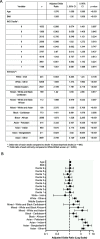Retrospective cohort study of the association between socioeconomic deprivation and incidence of gestational diabetes and perinatal outcomes
- PMID: 38225599
- PMCID: PMC10790393
- DOI: 10.1186/s12889-023-17261-8
Retrospective cohort study of the association between socioeconomic deprivation and incidence of gestational diabetes and perinatal outcomes
Abstract
Introduction: Socioeconomic disparities have been shown to correlate with perinatal mortality and the incidence of type 2 diabetes. Few studies have explored the relationship between deprivation and the incidence of gestational diabetes (GDM). We aimed to identify the relationship between deprivation and incidence of GDM, after adjusting for age, BMI, and ethnicity. We also examined for relationships between deprivation and perinatal outcomes.
Methods: A retrospective cohort analysis of 23,490 pregnancies from a major National Health Service Trust in Northwest London was conducted. The 2019 English Indices of Multiple Deprivation was used to identify the deprivation rank and decile for each postcode. Birthweight centile was calculated from absolute birthweight after adjusting for ethnicity, maternal height, maternal weight, parity, sex and outcome (live birth/stillbirth). Logistic regression and Kendall's Tau were used to identify relationships between variables.
Results: After controlling for age, BMI & ethnicity, Index of Multiple Deprivation postcode decile was not associated with an increased risk of developing gestational diabetes. Each increase in decile of deprivation was associated with an increase in birthweight centile by 0.471 (p < 0.001). After adjusting for confounders, age was associated with a 7.1% increased GDM risk (OR: 1.076, p < 0.001); BMI increased risk by 5.81% (OR: 1.059, p < 0.001). There was no significant correlation between Index of Multiple Deprivation rank and perinatal outcomes.
Discussion: Our analysis demonstrates that socioeconomic deprivation was not associated with incidence of GDM or adverse perinatal outcomes. Factors such as genetic predisposition and lifestyle habits may likely play a larger role in the development of GDM compared to socioeconomic deprivation alone.
Keywords: Birthweight centile; Deprivation; Gestational diabetes mellitus; Perinatal outcomes.
© 2024. The Author(s).
Conflict of interest statement
The authors declare no competing interests.
Figures



Similar articles
-
Induction of labour at 39 weeks and adverse outcomes in low-risk pregnancies according to ethnicity, socioeconomic deprivation, and parity: A national cohort study in England.PLoS Med. 2023 Jul 20;20(7):e1004259. doi: 10.1371/journal.pmed.1004259. eCollection 2023 Jul. PLoS Med. 2023. PMID: 37471395 Free PMC article.
-
Characteristics and outcomes of pregnant women with type 1 or type 2 diabetes: a 5-year national population-based cohort study.Lancet Diabetes Endocrinol. 2021 Mar;9(3):153-164. doi: 10.1016/S2213-8587(20)30406-X. Epub 2021 Jan 28. Lancet Diabetes Endocrinol. 2021. PMID: 33516295
-
Outcomes of twin pregnancies complicated by gestational diabetes: a meta-analysis of observational studies.J Perinatol. 2017 Apr;37(4):360-368. doi: 10.1038/jp.2016.254. Epub 2017 Jan 12. J Perinatol. 2017. PMID: 28079866
-
Risk factors for adverse outcomes in twin pregnancies: a narrative review.J Matern Fetal Neonatal Med. 2023 Dec;36(2):2240467. doi: 10.1080/14767058.2023.2240467. J Matern Fetal Neonatal Med. 2023. PMID: 37518183 Review.
-
Fetal biometry for guiding the medical management of women with gestational diabetes mellitus for improving maternal and perinatal health.Cochrane Database Syst Rev. 2019 Sep 3;9(9):CD012544. doi: 10.1002/14651858.CD012544.pub2. Cochrane Database Syst Rev. 2019. PMID: 31476798 Free PMC article.
References
-
- Global Report on Diabetes. Geneva: World Health Organization; 2016. Available from: https://www.who.int/diabetes/global-report/en/.
-
- Gestational diabetes mellitus. BMJ Best Practice. Available from: https://bestpractice.bmj.com/topics/en-us/665/aetiology. Cited 6 February 2022.
-
- Langer O. Gestational diabetes: The consequences of not-treating. InTextbook of Diabetes and Pregnancy, Second Edition 2008 (pp. 127–137). CRC Press.
MeSH terms
LinkOut - more resources
Full Text Sources
Medical

